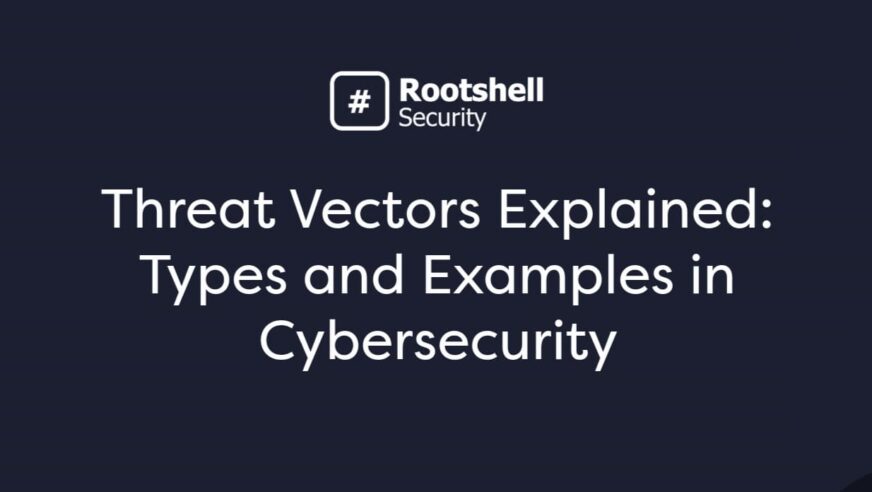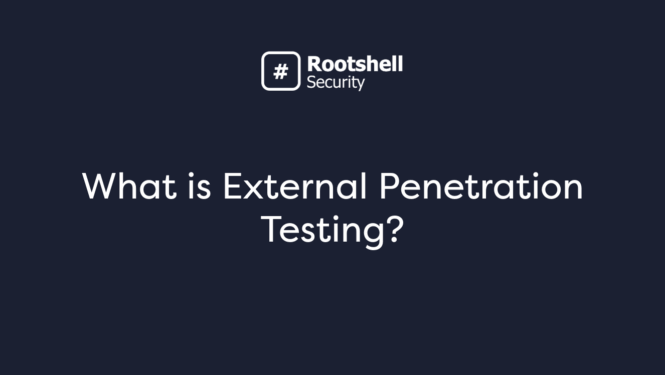It’s no secret that the range and severity of cyber threats are growing, but are you truly prepared to face them? PwC’s 2025 Global Trust Insights Survey found that only 2% of organizations have implemented cyber resilience across their operations, despite 66% of tech leaders ranking cybersecurity as a top risk.
While most businesses understand the importance of cybersecurity, many still struggle to defend against threats. It is important to identify the right approach to protect your organization as these threats continue to grow.
With a variety of competing cybersecurity strategies available, it can be overwhelming to decide which one is the best approach. In this post, we’ll explore threat vectors and other cybersecurity concepts in detail and explain how each plays a key role in protecting your organization.
Why Understanding Threat Vectors Matters
Understanding these terms is not just an academic exercise—they’re the foundation for forming your cybersecurity defense. As cybercriminals grow more sophisticated, it’s no longer enough to just identify vulnerabilities, you need to know where you’re vulnerable (attack surface), how attackers might get in (attack vector), and what the potential damage could be (threat vector).
By breaking down each of these elements, you can:
- Identify risks more effectively: knowing your attack surface allows you to map out potential vulnerabilities, while understanding attack vectors and threat vectors lets you know how attackers are most likely to target you.
- Proactively manage threats: Once you know your attack surface and threat vectors, you can put in controls to prevent attackers from exploiting those pathways.
- Prioritize resources: By understanding which attack vectors are most likely to be used against you, you can focus your resources where they will be most effective, addressing high-risk threats before they become serious issues.
Examples of Threat Vectors and How to Control Them
Phishing
Phishing is one of the most common and effective threat vectors used by cybercriminals. It typically involves sending fraudulent emails that appear to be from legitimate sources. The goal is to trick the recipient into revealing sensitive information, such as login credentials or financial details. To help organizations identify weaknesses in their defenses, Rootshell offers a Phishing Assessment that simulates real-world phishing attacks and uncovers how users might respond so you can address vulnerabilities before attackers do.
Prevention Tips:
- Educate employees on how to recognize phishing attempts. For tips and tricks on phishing, and common pitfalls we see in organizations, take a look at our article ‘Phishing: Slipping The Net’ written by Andrew, our Head of Social Engineering & Network Infrastructure Services.
- Implement email filtering tools to block malicious emails.
- Use multi-factor authentication (MFA) to add an extra layer of security.
Malware
Malware is malicious software designed to harm or exploit a computer system. It can come in various forms, including viruses, worms, trojans, and ransomware.
Prevention Tips:
- Install and regularly update antivirus software.
- Keep operating systems and software updated with the latest security patches.
- Avoid downloading software or opening attachments from untrusted sources.
- Install and regularly update antivirus software.
Denial of Service (DoS) and Distributed Denial of Service (DDoS)
A Denial of Service (DoS) attack occurs when an attacker floods a system with excessive traffic, making it unavailable to legitimate users. A Distributed Denial of Service (DDoS) attack uses multiple compromised systems to amplify the attack, making it harder to defend against.
Prevention Tips:
- Use firewalls and intrusion detection systems to monitor network traffic.
- Implement traffic filtering techniques to block malicious requests.
- Employ load balancers to distribute traffic and prevent system overload.
Insider Threats
Insider threats come from individuals within an organization who misuse their access to compromise data or systems. This can include employees, contractors, or business partners.
Prevention Tips:
- Implement strict access controls and limit user privileges based on job roles.
- Monitor employee activity using security auditing tools.
- Conduct regular security awareness training to deter malicious behavior.
- Implement strict access controls and limit user privileges based on job roles.
Man-in-the-Middle (MitM) Attacks
In a Man-in-the-Middle (MitM) attack, the attacker intercepts communications between two parties, often to steal sensitive data such as login credentials or financial information.
Prevention Tips:
- Use encryption protocols like SSL/TLS to secure communication channels.
- Educate employees about the dangers of using unsecured public Wi-Fi networks.
- Implement VPNs to protect data transmission over the internet.
Ransomware
Ransomware is a type of malware that locks a user’s files or system and demands payment for their release. It is often delivered via phishing emails or malicious websites, making it a highly disruptive and costly threat. To learn more about your vulnerabilities, take a look at our Ransomware Assessments that simulate real-world attacks and help you strengthen your defenses against attacks.
Prevention Tips:
- Regularly back up important data so that files can be recovered without paying the ransom.
- Use robust endpoint protection and keep it up to date.
- Educate employees about not clicking on suspicious links or downloading unfamiliar attachments.
Threat Vectors, Attack Vectors, and Attack Surfaces
Threat vectors, attack vectors, and attack surfaces are often used interchangeably, but they represent different aspects of how attackers operate and how vulnerabilities are exposed.
Attack Surface
Your attack surface refers to the total sum of all potential points of entry into your system, network, or application. This includes all devices, users, services, and pathways that could be exploited by an attacker. Simply put, the attack surface is where cybercriminals can potentially break in. Understanding and managing this exposure is important—attack surface identification, mapping, and management help organizations gain full visibility into these entry points.
The larger the attack surface, the more vulnerabilities there are to address. For example, if your network is exposed to the public internet with minimal safeguards, you have a larger attack surface. By contrast, a network protected with strong access controls and firewalls has a smaller, more manageable attack surface.
Attack Vector
An attack vector is the route or method an attacker uses to abuse a vulnerability. It’s the “how” of an attack—the technique used to gain access to a system.
Attack vectors can take many forms, including software vulnerabilities, misconfigured systems, social engineering tactics, and even physical access to devices. These vectors may target different components of an organization’s infrastructure, such as servers, workstations, mobile devices, and employees, posing risks to both technical and human elements of security.
Threat Vector
A threat vector, while similar to an attack vector, is broader in scope. It covers the methods and pathways used by cybercriminals to breach systems. A threat vector is not just about how the attack happens (the vector) but also about the motivations behind the attack and the damage it might cause.
Threat vectors combine both the “how” (attack vector) and the “why” (the intent of the attacker), giving you a full picture of the threat. They help security teams not only address vulnerabilities but also anticipate the types of harm an attack might cause.
How Attackers Exploit Threat Vectors
Cybercriminals are relentless in their pursuit of vulnerabilities. According to a study from the University of Maryland’s A. James Clark School of Engineering, cyberattacks occur over 2,200 times daily, with someone falling victim every 39 seconds.
Here’s how hackers typically operate:
Social Engineering: Hackers take advantage of human psychology through social engineering techniques. By manipulating individuals into revealing confidential information or performing actions that compromise security, they can bypass traditional technical defenses. Learn more about social engineering attacks and how to protect your team in our guide to social engineering in cybersecurity
Exploiting Software Vulnerabilities: In these cases, attackers expose known vulnerabilities in outdated or unpatched software. Keeping your systems up-to-date is one of the best ways you can prevent this.
Brute Force Attacks: Hackers try every possible password combination until they gain access to an account or system.
Zero-Day Exploits: These attacks expose vulnerabilities that haven’t been discovered or protected yet, making them very dangerous. Continuous vulnerability scanning helps identify these potential entry points early, allowing you to fix them before they can be exploited.
Man-in-the-Middle (MitM) Attacks: Hackers intercept communications between two parties to steal data or inject malicious code.
Strategies for Managing Threat Vectors
Continuous Monitoring
It’s important to continuously monitor your devices, making sure you stay aware of any new points of vulnerability that could be infiltrated. Data discovery tools can help identify hidden or overlooked assets in your organization. Implementing a solution like Attack Surface Management (ASM) can help you continuously monitor and manage your infrastructure.
Vulnerability Management
Vulnerability management can help you to understand where your systems may be at risk. Once vulnerabilities are discovered, prioritize them based on the potential threat and take the appropriate actions. This helps reduce the potential attack vectors hackers could exploit.
Access Control and Authentication
Access control measures, such as multi-factor authentication (MFA) and strict user permissions, can reduce your attack surface by making sure that only authorized individuals can access critical systems. For example, securing service accounts with MFA in Azure and Microsoft 365 helps prevent unauthorized access to privileged accounts that are often overlooked. You can learn more about this in our blog MFA Service Accounts in Azure and Microsoft 365
Employee Education and Awareness
Since human error is a common entry point for attackers, educating employees on how to recognize phishing attempts and other social engineering tactics is important for reducing risks. To better understand how attackers craft these deceptive campaigns, explore Rootshell’s deep dive into phishing techniques in Phishing: Inside the Attacker’s Tacklebox.
Penetration Testing and Red Teaming
Regularly assessing your security posture through penetration testing and red teaming exercises provides deep insight into how attackers could compromise your systems. Solutions like Penetration Testing as a Service (PTaaS) and Red Team as a Service simulate real-world threats, helping you discover and fix potential attack vectors.
Emerging Threat Vectors in Cybersecurity
As much as we like to believe we are prepared for any kind of cybersecurity attack, the truth is that technology is becoming more and more sophisticated as time passes. New threat vectors continue to develop that we need to stay aware of. Here are some examples we wanted to include in this article:
- Cloud Security Issues: Now that a lot of businesses rely heavily on cloud-based services, attackers are targeting weaknesses in a cloud network. Misconfigurations, weak authentication, and insecure APIs are common vulnerabilities.
- AI-Driven Attacks: Artificial intelligence is being used by cybercriminals to automate attacks, making them faster and more sophisticated. AI can be used for identifying system weaknesses and executing large-scale phishing campaigns.
- Deepfakes: Deepfake technology, which creates realistic fake audio and video content, is used for malicious purposes, including fraud and social engineering attacks.
Build a Stronger Cybersecurity Strategy with Rootshell Security
While security solutions can offer stronger protection, they also require the right expertise and resources to be implemented effectively. Without a clear understanding of your attack surface or how attackers could gain access, even the most sophisticated tools may fall short.
At Rootshell, we help organizations take control of their cybersecurity with solutions designed to identify, manage, and reduce risk. Ready to strengthen your defenses? Book a demo with one of our experts today.
Frequently Asked Questions
How can businesses protect themselves from phishing attacks?
Businesses can implement email filters, educate employees on recognizing phishing attempts, and use multi-factor authentication to protect against attacks.
Are threat vectors different in small businesses vs large enterprises?
Yes, the nature of the threat vectors may differ based on the scale and complexity of the business. Small businesses may be more susceptible to social engineering attacks, while large enterprises might face more sophisticated attacks such as advanced persistent threats (APTs).
What are the most common threats to mobile devices?
Common mobile threats include malware, phishing, and data leakage from unsecured apps. It’s essential to use mobile device management (MDM) solutions and ensure apps are downloaded from trusted sources.
How do threat vectors impact cybersecurity in the cloud?
Cloud environments introduce new vulnerabilities, such as misconfigured settings, weak authentication mechanisms, and insufficient access controls. Organizations must implement strong security practices and regularly audit their cloud infrastructure.



